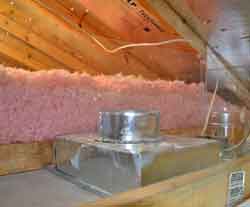 Attic insulation is the solution most homeowners think of when they have ice dams. A warm winter coat is like attic insulation. But you need more than a warm coat — you need a hat, scarf, gloves, etc. The coat will slow the loss of body heat but what about the gaps where your coat sleeves don't quite reach your gloves or hat?
Attic insulation is the solution most homeowners think of when they have ice dams. A warm winter coat is like attic insulation. But you need more than a warm coat — you need a hat, scarf, gloves, etc. The coat will slow the loss of body heat but what about the gaps where your coat sleeves don't quite reach your gloves or hat?
Your attic insulation is always working but for better energy efficiency, you can close the gaps where heat leaks into the attic.
Attic Insulation
Insulation reduces the unwanted flow of heat between your home and the outdoors — heat loss in the winter, heat gain in summer. The goal is to make your home comfortable and more energy efficient.
As energy costs have risen, building codes have gotten more stringent to reduce the amount of energy needed to heat our homes. There are many different types of insulation and the critical things to understand when buying attic insulation are the recommended R-values (Energy Star recommended insulation levels for retrofitting your home) and how to install insulation properly.
 The effectiveness of insulation is based on the R-value, which you can't determine by looking at the attic insulation you already have, although the Energy Star tables will help you guesstimate what's there. Equally important is the quality of the installation because:
The effectiveness of insulation is based on the R-value, which you can't determine by looking at the attic insulation you already have, although the Energy Star tables will help you guesstimate what's there. Equally important is the quality of the installation because:
- All gaps from your home's living area should be sealed before insulating using caulking, foam and weather stripping around the entry door into your attic. The FamilyHandyman.com website has nice step-by-step directions for adding attic insulation if you're a do-it-yourself homeowner and remember, it's the details that will make the difference.
- You need to install attic baffles (also called proper vents) before adding insulation to your attic floor, to insure there's enough airflow coming in from your soffits, for attic ventilation.
Sealing Gaps That Allow Air to Leak Into Attic
There's a reason why heating companies are called HVAC (Heating, Ventilation and Air Conditioning). So why are we talking about sealing gaps? That's where our winter coat analogy helps explain things. Your winter coat and gloves might be rated for minus 40° but what happens if your wrist is exposed to the cold, i.e. that's a gap that needs to be sealed and sealing gaps will help your attic insulation be more effective too.
There are lots of holes in the attic floor and each one of these gaps lets more heat escape into the attic. While your attic insulation will slow the transfer of this heat to the attic cavity and ultimately your roof, it's much better if you seal all these gaps to reduce the amount heat that enters your attic.
 Things hidden inside your walls including electrical wiring, plumbing and duct work.
Things hidden inside your walls including electrical wiring, plumbing and duct work.- Recessed ceiling light fixtures called high hats but research as fire safety is a factor here.
- Gaps around chimneys may have gaps, and also need special handling.
- Your attic access door should be insulated, plus weatherstripping fills gaps.
Attic Ventilation for Energy Efficiency
Ventilation isn't well understood by homeowners, as most of my handyman customers called for help installing more attic insulation. It takes a while to explain how ventilation works to get rid of warm air in the attic because warm air under the roof causes snow to melt ice dams to form (learn more about ice dams). It's not until you do research on ice dams that you even realize that today's ridge vents won't work if your roof is covered with snow … so now what?
Let's look at the purpose of attic ventilation, which works in conjunction with your attic insulation?
- During warm months, ventilation helps keep your attic cool and reduces the demand on air conditioning.
- During colder months, ventilation's role is to remove warm air from your attic. Otherwise the moisture will turn to water, which can damage the attic insulation, attic flooring and the roof deck above … and let's not forget, that most of us store lots of things in the attic too.





Leave a Reply